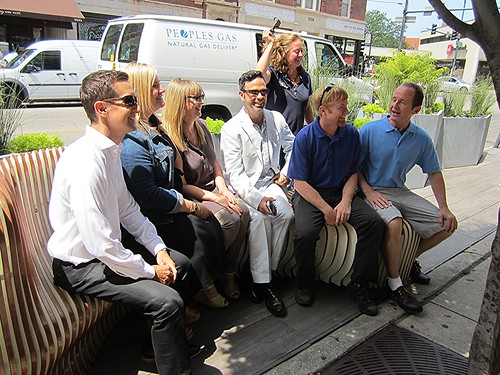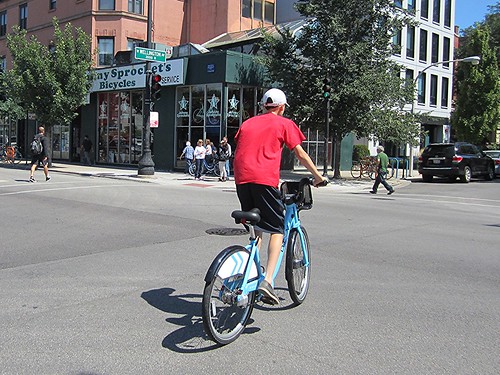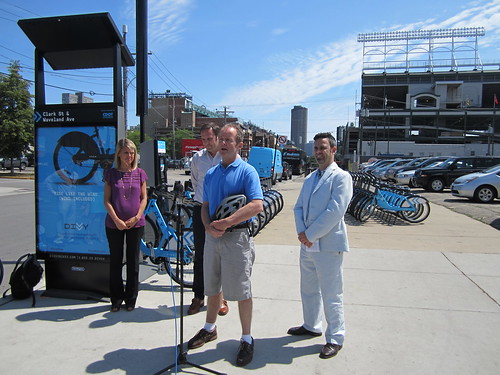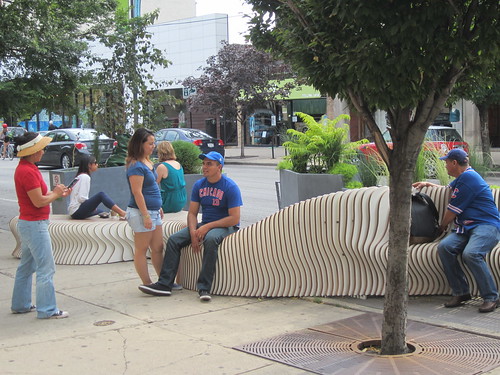32nd Ward Alderman Scott Waguespack, usually a progressive on transportation issues, recently made some backward comments about city initiatives that convert car parking spaces into facilities like Divvy stations, bike parking corrals and People Spot seating areas. Waguespack fretted about the impact these conversions would have on local businesses, but it’s clear that these innovative uses can be more effective ways to draw visitors to retail strips than simply warehousing cars on the public way. Even after I staked out a bike-share station in his ward and found that 12 customers used it during a two-hour period, while there was zero turnover at two adjacent car spaces, the alderman still wasn’t convinced.
44th Ward Alderman Tom Tunney seems to have a much better understanding that it’s much more important to bring people to business districts than to accommodate cars. Tunney did honor a request from Manuel Tenorio, owner of the two Johnny Sprockets bicycles stores, to put the kibosh on a proposed Divvy station near his shop at Broadway and Wellington in Lakeview. However when I recently interviewed the alderman at the ribbon cutting for a station at Wrigley Field, shortly before another ribbon cutting down the street for the a People Spot at Southport and Addison, he explained his reasoning for that decision and expressed support for swapping car spots for more productive uses.
JG: I heard there were a few situations in your ward where merchants weren’t happy about Divvy stations being located by their businesses. For example, Johnny Sprockets requested that a station not be installed there. How have things been going with that lately?
TT: We’re cognizant of trying to find the best locations for the users. I think we’re doing over 40 installs in a very small [in area] ward. So you’ll always have conflicts with that. We’re looking at those four corners over there [at Broadway and Wellington]. Like at this intersection [by the stadium, at Clark and Waveland], we looked at which corner would work for everybody. So it’s always a balance.
And as far as Johnny Sprockets is concerned, they’re such an asset in the community. They’ve got their bike racks already there. They’ve got their storage on the Wellington side, so at any given time there’s like 40 different bikes that they use for retailing and merchandising and stuff like that.
Like I said, we’re going to work with everybody and try to find as many locations that Divvy would like us to do. And in other cases where there’s a parking meter conflict. [The city’s parking meter contract requires any metered spaces removed to be replaced with new spaces elsewhere.] There are all kinds of conflicts when you’re trying to roll out something of this scale in a very short period of time.
JG: So is a station getting installed at the intersection where Johnny Sprockets is?
TT: My staff is working on that. [There’s a Divvy station] at Clark and Wellington, which is basically just a half block from that intersection, and there’s also one at Wellington and Lake Shore Drive. Broadway is actually one of the more narrow commercial streets. Across the street there’s a 15-minute loading zone for Bobtail ice cream. But we’ll figure it out. I’m pretty happy with the Divvy program and the installations. You know, there’s always going to be some wrinkles in a rollout like this.
JG: What’s your perspective on the issue of swapping on-street parking spaces for Divvy stations, on-street bike parking corrals and People Spots? Is that something that you’re generally willing to do?
TT: Sure. Obviously this is an initiative that I think resonates well with our residents. I think there’s room for it all. The one thing is that we’re going to have to give up a few metered spaces, with the meter contract, if you take some out, you gotta be able to see if you can put in more metered spaces [elsewhere].
The thing about the 44th Ward is it’s almost 100 percent metered on every arterial street, and even the wraparounds [segments of residential streets near arterial intersections]. So we’re going to have make sure that we act to make this a priority but also make sure that it doesn’t have a financial consequence that’s detrimental to the taxpayer.
JG: But you’re generally OK with doing one-for-one swaps, removing metered spots in one location and then creating new ones in another?
TT: Sure, I’m all for removing metered spots, but there is a financial consequence. And so when you put in an ordinance to remove meters, when you go in front of the [city’s Finance Committee] they’re going to say, “What are we doing to not impact the entire agreement?” We just went through that just two months ago in regards to true-ups and so we want to make sure… I think we can do it all.
JG: But if you’re able to find two metered spots to replace the two spots you’re taking out, then you’re OK with that?
TT: Yeah.
JG: A People Spot usually takes up two parking spaces and/or a loading zone. Do you think that’s a worthwhile swap? Would you say a People Spot is more valuable than two parking spaces?
TT: Yes, because it allows the street to be more engaging. It is pedestrian friendly, it helps with traffic calming, and it makes our streets and our city more vibrant. [The city of Chicago] introduced sidewalk cafes years ago, and this is something else that’s part of the same concept of making our streets more vibrant, more livable, more pedestrian-friendly, and just more relaxing.
JG: How do you feel People Spots help with traffic calming?
TT: They slow down traffic. And what we’ve been trying to do as a city is make sure that the roads and the sidewalks are safe for bicyclists and pedestrians, and we gotta do more to increase safety.







